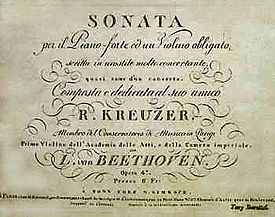| Mp3s Biography Sheetmusic | Ludwig van Beethoven opus 47Sonata No. 9 for violin with piano "Kreutzer"Piano Sonata in A major. 1803. Time: 34'30.Originally dedicated to Bridgetower, but Beethoven withdrew the dedication after a quarrel and dedicated it to Kreutzer instead. |
| Buy sheetmusic for this work at SheetMusicPlus |

Kreutzer Sonata, painting by René François Xavier Prinet (1901)
Violin Sonata No. 9 in A major, commonly known as the Kreutzer Sonata, is a violin sonata which Ludwig van Beethoven published as his Opus 47. It is known for its demanding violin part, unusual length (a typical performance lasts slightly less than 40 minutes), and emotional scope — while the first movement is predominantly furious, the second is meditative and the third joyous and exuberant. The sonata was originally dedicated to the violinist George Bridgetower (1780–1860) who performed with Beethoven at the premiere in 1803 at an 8:00 am concert. However, research indicates that after the performance, while the two were drinking, Bridgetower insulted the morals of a woman whom Beethoven cherished. Enraged, Beethoven removed the dedication of the piece, dedicating the piece instead to Rodolphe Kreutzer, considered the finest violinist of the day.[1] However, Kreutzer never performed it, considering it unplayable, even though his name is now attached to it.[2] Sources suggest the work was originally titled "Sonata mulattica composta per il mulatto Brischdauer [Bridgetower], gran pazzo e compositore mulattico" (Mullato Sonata composed for the mulatto Brischdauer, big wild mulatto composer), and in the composer's 1803 sketchbook, as a "Sonata per il Pianoforte ed uno violino obligato in uno stile molto concertante come d’un concerto".[3]
StructureThe piece is in three movements, and takes approximately 37 minutes to perform:
The sonata begins with a slow chordal introduction in the major played by the violin. The piano enters, and the harmony begins to turn darker towards the minor, until the main body of the movement—an angry A minor Presto—begins. Here, the piano part matches the violin's in terms of difficulty. Near the end, Beethoven brings back part of the opening Adagio, before closing the movement in an anguished coda. There could hardly be a greater contrast with the second movement, a placid tune in F major followed by five distinctive variations. The first variation transliterates the theme into a lively triple meter while embellishing it with trills, while in the second the violin steals the melody and enlivens it even further. The third variation, in the minor, returns to a darker and more meditative state. The fourth recalls the first and second variations with its light, ornamental, and airy feel. The fifth and final variation, the longest, caps the movement with a slower and more dramatic feel, nevertheless ending in carefree F major. The calm is broken by a crashing A major chord in the piano, ushering in the virtuosic and exuberant third movement, a 6/8 tarantella in rondo form. After moving through a series of slightly contrasting episodes, the theme returns for the last time, and the work ends jubilantly in a rush of A major. This finale was originally composed for another, earlier, sonata for violin and piano by Beethoven, the Op. 30, no. 1, also in A major[4]. Media
See also
References
External links
| |||||||
This article is licensed under the GNU Free Documentation License. It uses material from the Wikipedia article "Violin_Sonata_No._9_(Beethoven)". Allthough most Wikipedia articles provide accurate information accuracy can not be guaranteed. | |||||||
Help us with donations or by making music available!
©2023 Classic Cat - the classical music directory

Beethoven, L. van
Symphony No. 3 "Eroica"
Bamberger Symphoniker
Beethoven, L. van
Symphony No. 9 "choral"
Toonkunstkoor Amsterdam
Beethoven, L. van
Für Elise
Mauro Bertoli
Chopin, F.
Piano Concerto No. 1
Dimitris Sgouros
Beethoven, L. van
Symphony No. 5 in C minor
New York Philharmonic Orchestra
Beethoven, L. van
Symphony No. 6 "Pastorale"
Vienna Philharmonic

